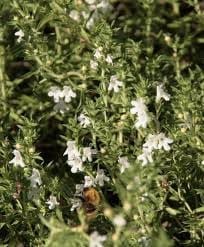| Maturity (days) | Perennial |
|---|---|
| Plant height (cm) | 35-40 |
| Spreading (cm) | 30-40 |
| Formulation | Untreated |
Winter Savory
Winter Savory
3.59$
In stock
Winter Savory has been added to cart
Buy 3 and get a 10% discount
It can be compared to Summer Savory, but with a more pronounced flavour. Leaves are greyish green, with beautiful white or pink flowers. Multiple culinary and medicinal uses. Very attractive as a mini shrub or border plant.
Cultivation mode
Plantation : Indoor: we sow them, in April, the seeds require light to germinate and a temperature between 15 °C and 21 °C. Germination is slow between 14 to 20 days. Outdoor: sow them in rows 30-40 cm apart. Thin the seedlings to 30 cm when the plants have 3 to 4 leaves. Container: for indoor winter cultivation, in August, a few seeds (10) are sown in containers 15 cm in diameter. They are left Outdoor in partial shade to germinate. The containers of young shoots entered towards the end of September.
Soil : Indoor: A well-drained, porous seedling soil is ideal for preventing overwatering. Outdoor: the soil must be light, draining and above all not clay. In the latter case, bring sand that you mix with your soil and put in place good drainage at the bottom of the hole.
Spacing : space 30 cm in the row and 30-40 cm between the rows.
Cultural practices : the maintenance of savory is quite simple. She likes hot and sunny temperatures, she easily finds her place on a terrace or a balcony. It does not require much water. It is enough to weed every now and then, as it can easily get overgrown. For a continuous harvest, make successive showing every three and four weeks.
Harvest : savory stems are harvested in summer. To preserve them, you can dry or freeze the leaves. To do this, harvest the stems just before flowering, this is where they taste the most. To preserve the flavour, hang small bundles of leafy stems upside down to dry, then place them in an opaque, airtight container.
| Latin name |
Satureja hortensis |
|---|---|
| Companion plants |
bean, Brussels sprouts, cabbage, cauliflower, garlic, onion |
| Rival plants |
cucumber, cornichon, sage |

